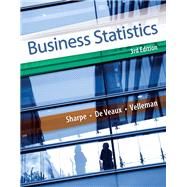Note: You are purchasing a standalone product; MyStatLab does not come packaged with this content. If you would like to purchase both the physical text and MyStatLab, search for ISBN-10: 0133866912/ISBN-13: 9780133866919. That package includes ISBN-10: 032192147X/ISBN-13: 9780321921475, ISBN-10: 0321929713/ISBN-13: 9780321929716, and ISBN-10: 0321925831/ISBN-13: 9780321925831.
MyStatLab is not a self-paced technology and should only be purchased when required by an instructor.
Package consists of
032192147X/9780321921475 - MyStatLab for Business Statistics -- Glue-In Access Card
0321929713/0321929713 / 9780321929716 - MyStatLab for Business Statistics Sticker
0321925831/9780321925831 - Business Statistics, 3/e
Business Statistics, Third Edition , by Sharpe, De Veaux, and Velleman , narrows the gap between theory and practice—relevant statistical methods empower business students to make effective, data-informed decisions. With their unique blend of teaching, consulting, and entrepreneurial experiences, this dynamic author team brings a modern edge to teaching statistics to business students. Focusing on statistics in the context of real business issues, with an emphasis on analysis and understanding over computation, the text helps students be analytical, prepares them to make better business decisions, and shows them how to effectively communicate results.








